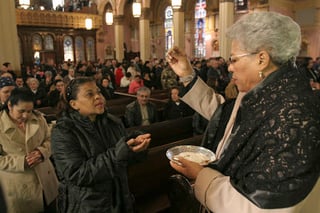Editor's note: Today, I'm very happy to share the first of a series of blog posts being shared by the United States Council of Catholic Bishops for the Year of Faith. We thank the USCCB for making this post available for our readers. LMH
 Photo Courtesy Catholic News Service
Photo Courtesy Catholic News Service
The Council at 50: Mass Post-Vatican II, A Participatory Event
Welcome to one of the series of blogs on the Second Vatican Council. Each piece reviews one of the 16 documents produced by the Council Fathers during the extraordinary occasion in Church history. Vatican II, which drew together the world’s bishops, opened fifty years ago in St. Peter’s Basilica, October 11, 1962.
Looking over the 50 years since the opening of the Second Vatican Council, it’s clear that the most obvious effects of the Council’s work are seen in the liturgy, especially in the celebration of the Mass. Sacrosanctum Concilium, the Constitution on the Sacred Liturgy, was the first of the Council’s major documents and set the course for the liturgical reform.
Its influence,still visible today, continues to chart the course for the celebration of Mass and the other sacraments. Five lasting effects ofSacrosanctum Concilium stand out.
1. Participation: One oft quoted statement of the Council is paragraph 14 of the Liturgy Constitution: “Mother Church earnestly desires that all the faithful should be led to that fully conscious, and active participation in liturgical celebrations which is demanded by the very nature of the liturgy.” When the Church gathers for Mass or any other sacrament, all assembled are engaged in what is taking place, by praying aloud, singing, standing, kneeling, moving in procession, and, for some, fulfilling particular functions such as assisting as altar servers, proclaiming the Scripture readings, or presiding over the celebration as the celebrant (the priest). Now taken for granted, these changes in the liturgy were steps to foster and express our interior participation of the heart and mind in the work of Jesus. In the Mass, all the faithful participate in the offering of the gifts, and in doing so participate by offering themselves – their devotion and lives of service – to the Lord.
2. Enculturation: Even as Catholics throughout the world celebrate the same Mass, we do so now in our own languages, making use of elements of our own cultures: styles and forms of music, art, and architecture, and praying about what concern us. The liturgy is both the experience of God’s saving presence, it is also an expression of who we are before God. In a culturally diverse society, we are still challenged to celebrate the liturgy in a way that enables everyone to worship and pray.
3. Ministry: Prior to the liturgical reforms of the Council, the liturgy was seen as the work of the priest and those few assistants at the altar. Today the liturgy is supported by a variety of ministries (deacons, readers, servers, music ministers, etc.), and the work of the Church is carried out daily by a broad spectrum of people serving, leading, and teaching in the name of the Church.
4. Catechesis: The liturgical reforms introduced in the years after the Second Vatican Council required a great deal of explanation and instruction for everyone. The Constitution on the Sacred Liturgy stressed the importance of such teaching as a way to lead the faithful to effective and fruitful participation in the liturgy. Today we continue to teach about what the Mass means and how to worship well. Recently, for example, dioceses and parishes underwent a great effort to teach about the Mass in preparation for the introduction of the Roman Missal, Third Edition.
5. Mission: Sacrosanctum Concilium teaches that the liturgy is the “source and summit” of the Christian life (see paragraph 10). We don’t just gather at Mass to worship, but also to be energized and sent forth on a mission: to keep the commandments, above all to love God and love our neighbor. And the Mass ends with that reminder: “Go in peace, glorifying the Lord with your life.”
Archbishop Gregory Aymond of New Orleans chairs the Committee on Divine Worship of the U.S. Conference of Catholic Bishops.
About the Author

Guest
We welcome guest contributors who graciously volunteer their writing for our readers. Please support our guest writers by visiting their sites, purchasing their work, and leaving comments to thank them for sharing their gifts here on CatholicMom.com. To inquire about serving as a guest contributor, contact editor@CatholicMom.com.


.png?width=1806&height=731&name=CatholicMom_hcfm_logo1_pos_871c_2728c%20(002).png)
Comments